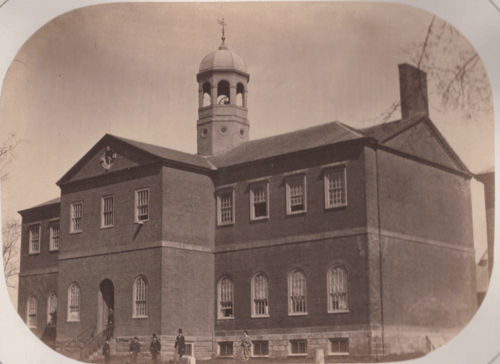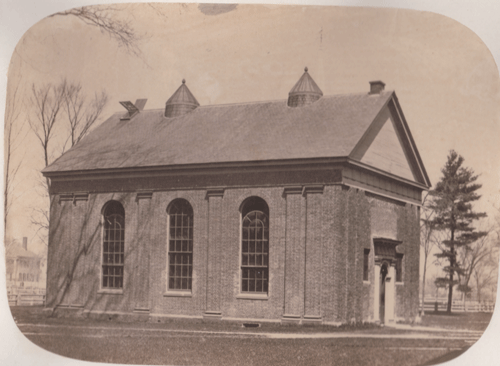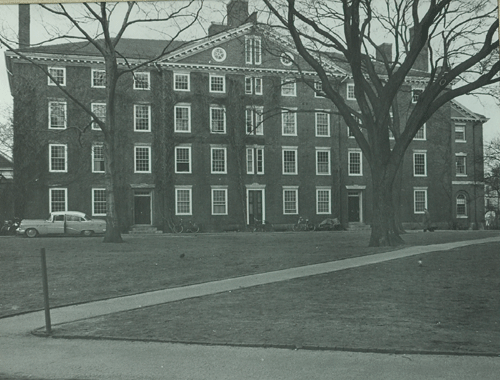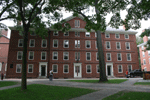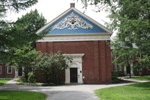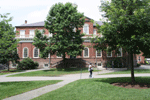Harvard College
Since its founding in 1636, Harvard has been an integral part of Cambridge. During the Revolutionary era, it was comprised of five buildings: Holden Chapel and four halls named Massachusetts, Harvard, Hollis, and Stoughton. Harvard Hall housed classrooms, two open quadrangles, and the College’s Unitarian Church. The College employed ten faculty members including its president. The Class of 1771 consisted of 63 graduates.
The collegiate structure was different then than it is today. The students, all males, ranged in age from eleven or twelve years old to the late twenties. The curriculum was rigid and electives were virtually unheard of. Scholars were taught Greek, Latin, mathematics, as well as physical and social science. By this point, not all students were training to be ministers; many went on to enter an array of professions. All were from New England; most were from well off families, though not necessarily “provincial aristocracy” like the Cambridge Tories.
Like many other communities in the early 1770s, Harvard College established its own militia. Once the War broke out, it offered its soldiers to the Revolutionary Cause. However, they were rejected and instructed instead to fulfill a higher calling of pursuing their education. Before bullets flew, cannons were fired, and lives were sacrificed, the Harvard campus was afflicted with its own tensions. Though its loyalist population was small, it did still exist. In early 1775, only a year after the Boston Tea Party, two Harvard students, in a provocative act, brought tea to the dining hall for breakfast. Enraged patriotic students reacted by breaking dishes. It is unclear whether or not a full-fledged fistfight ensued, but tea was subsequently banned from all meals. At the same time, Harvard Hall continued to feature a monumental portrait of King George III and his wife, Queen Charlotte.
On the historic day of April 19, 1775, a brigade of British troops en route to Lexington to fight the colonists in the first battle of the American Revolution lost their way and ended up in Cambridge. In a defiant act that put him at odds with the entire Harvard Community, a faculty member, Isaac Smith, gave the soldiers directions. By 1775, the colonists’ contempt for British soldiers had grown fierce. Considering that Cantabridgians officially declared tea drinkers enemies of the colony, one can image how they reacted to Isaac Smith’s deed; he was forced to flee to Boston.
After Harvard was evacuated on May 1st of 1775, it was taken over by the Committee of Public Safety. The five buildings housed 1,680 soldiers in total, which was at the time greater than the entire population of Cambridge. When supplies dwindled, half a ton of lead from a roof was melted down for bullets. Some furniture and floorboards were used as firewood. The president of Harvard’s home also served as the temporary headquarters of George Washington. But after four days, he deemed it unsatisfactory and moved into a Tory Row estate for the rest of his time in Cambridge.
In October of 1775, classes resumed. Ironically, they had been moved to Concord, which was then deemed safer than Cambridge even after the very first battle of the Revolution was fought there, and no battle was ever fought in Cambridge. When classes resumed, not all the students decided to return. Many instead had joined the patriotic cause, fighting for their rights as Englishmen.
The Revolution itself changed the course of the lives every American colonist, presenting many hardships, and sacrifices that they had not imaged they would ever face. For Harvard graduates, it also presented new professional opportunities. The young nation desperately needed educated minds to lead it. Of the Revolutionary classes who graduated between 1775 and 1777, over 20% went into public service. The Harvard graduate, Reverend Huntington Porter orated, “If we confine our views to the last half century…O how great and wonderful are many of the changes that have occurred, not only in the world at large, or in our own country, but even in a single town, family, or individual.”
Harvard Buildings Today
 |
Back to Interactive Map |


